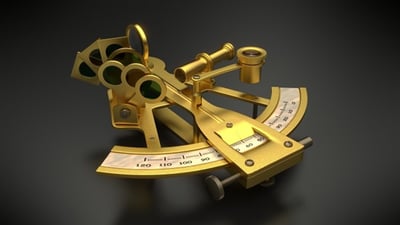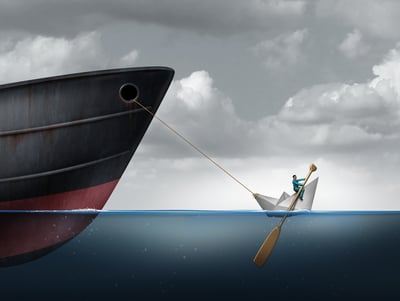It’s 1839.
You are here.
.png?width=400&height=234&name=You%20are%20here%20map%20(2).png)
How did you get “here” exactly? Well, we won’t bore you with the details. Suffice it to say it involved a time machine. And a malfunctioning geo-temporal modulator. And a lost bet with a peg-legged bartender in a seedy drinking establishment in a back alley somewhere in Tortuga. It’s all a bit convoluted really, and now you have to figure out where to head next. You need supply chain agility.
The point is, you find yourself standing on the deck of a ship, staring at endless ocean in every direction, wondering how on earth you’ll find your way to safe harbor. A navigator stands beside you with a strange device in his hands. He points it at the horizon, makes some minute adjustments, and then disappears below deck. When he returns a few minutes later, he hands you this odd device along with a map revealing your precise latitude and longitude.
Huzzah! You’ll live to time travel another day!
But in the meantime, what is this strange device in your hands that looks like the technological love child of a protractor and a telescope? And what does this new temporal adventure you’ve fallen into have to do with logistics service providers and an agile supply chain?
Well … we can explain.
A 30-second primer on 19th-century nautical celestial navigation
 That thing you’re holding is called a sextant.
That thing you’re holding is called a sextant.
Here’s a quick 101 for you.
Invented in 1757, the word “sextant” is derived from the Latin word “sextus” which (perhaps rather disappointingly) means one-sixth. This navigation device is so named because it works by measuring angles across an arc of 60 degrees, or one-sixth of a circle.
Here’s how it works. (It’s probably best to divest yourself of any cutlasses, parrots, or other swashbuckling paraphernalia before we proceed. I can hold them for you.)
First, stand on the edge of a ship. Now peer through the sextant’s lens and carefully align one marker with the horizon. All lined up? Great. Now point the other little marker at a fixed point in the sky. The sun is good (though you’ll need to spot it through a filter to protect your eyes). The moon or a convenient navigational star will work, too.
And that’s it! With the right calculations, you now have everything you need to extrapolate your latitudinal and longitudinal coordinates with remarkable accuracy.
These devices are astounding because they harness something incalculably massive to solve something deeply practical. With naught but a few grams of brass and glass, you too can use the location of Polaris, a flaming gaseous orb floating in the firmament over 300 light years away, to figure out how to avoid perishing of scurvy, starvation or Kraken-attack on the merciless high seas.
Now you have the basic gist, let’s complicate things a little, and delve into the three critical ingredients that make a sextant work.
Technology
A sextant is, of course, a technology. Its framework is a metallic circle precisely divided into degrees. A movable radial arm pivots at the center of the circle, while a sighting implement (more or less a telescope) is mounted rigidly to the arm, allowing you to accurately align a marker with the horizon.
It’s worth throwing manufacturing into the mix. This thing had to be robust enough to handle operational life at sea and forgiving enough to be operable on the open ocean.
That’s quite a bit of precision engineering bundled into one handheld device.
Process
It might be tempting to stop there and think of a sextant purely as an amazing and shiny thing. But it isn’t just technology. You see, the device on its own is next to useless.
To use a sextant, you also need an almanac to forecast the position of heavenly bodies. You require a fairly accurate way of telling the time — either using a chronometer or a method for pinpointing when the sky is directly overhead. Finally, of course, you need charts to plot your position.
In other words, the sextant relies on a process. It sits on top of a complex edifice of knowledge built on centuries of observation, calculation, and innovation.
Expertise
That navigator guy who stood beside you on the ship to sight the horizon with a sextant? Don’t be fooled by his scurvy-addled ramblings or that ridiculous pet monkey. He probably spent years gaining that level of proficiency.
There is much scope for human error when using such an intricate device. You have the error of perpendicularity where the optic components are out of alignment. There is the index error, where rough use or wear and tear minutely dislodge the marker used for sighting and indexing the horizon. If either of these or a score of other glitches occur, you’ll need to carefully recalibrate the device. If you perform these steps incorrectly you’ll get wildly inaccurate results.
And then there is just the natural “bias” each sextant possesses, thanks to tiny flaws in manufacturing. A bit like a musical instrument, every sextant is subtly different. With scientific instrument manufacturing still in its nascence, 19th-century navigators had to become experts in accounting for the peculiar eccentricities of their particular apparatus.
So expertise is a big part of this picture, it’s what differentiates supply chain agility from stagnation. A sextant is just a sea captain’s expensive executive stress management toy without a skilled navigator who knows how to use it.
Hmm... Technology, process, and expertise lead to supply chain agility, you say?
Whew! Which brings us to our point.

Back in 2022, you may find yourself figuratively lost at sea dealing with a complex supply chain problem. Many companies in this situation quickly realize the problem is too large to handle alone, and seek out a helpful navigator to deliver a solution.
The question is, what kind of help do you need?
The answer you get is going to depend on who you ask.
- Ask a 3PL that specializes in implementing third-party TMS packages only and they’ll instantly inform you that technology is the key. They’ll tell you only an advanced AI-augmented software package can get you out of your jam.
- Talk to a big consulting house, and they’ll nod sagely. They’ll say something about synergistics. Then after delivering a stunningly formatted slide deck, they’ll present you with a list of policy and guideline changes that’ll deliver the consistent processes you need to put your problem to rest.
- Consult a freelance supply chain adviser, and they’ll tell you that technology is probably what got you into this mess! Only a seasoned expert with the wisdom and insight to see the forest for the trees can save you now.
And, of course, they’re all valid answers from one fixed point of view. Broadly speaking, they’re all right. The problem is, they’re also all wrong.
Supply chain problems are intricate and challenging. The solutions to these kinds of problems aren’t generally found solely in a neat software package, or a more complicated bullet list of procedures, or even a cleverer and more experienced person. Solutions to tough challenges arrive as a synergy of technologies, process refinement, and industry-leading expertise.
You’ve traveled all the way back to 1839, lost a bet with an unscrupulous bartender in Tortuga, and probably have at least a few months at sea ahead of you – so hopefully you won’t mind if we elaborate on that a little.
Technology redux
A quality TMS carefully calibrated to your supply chain’s requirements is a precision instrument. There’s no question that the technology can help your team gain a precise handle on a wealth of important freight decisions. But just like a sextant, the technology has to be well-designed and fine-tuned often.
A typical 3PL will hand you a fixed TMS that can’t readily be refined or enhanced. The instant a storm hits (whether figurative or literal) or the tide of an ever-fluctuating carrier market nudges your technology out of alignment, that seamless technology begins to actively work against good decision-making. (For a cool story about just how stupidly brilliant technology can be, don’t eat Stan.)
Way back when IL2000 opened its doors for business, we took a different approach. We set about designing and building our own TMS technology — a tool we could optimize to meet the unique needs of each client. When logistics landscape shifts dictate a new logic or workflow, we recalibrate your technology so that it remains as accurate and reliable as ever.
Processes reexamined
We don’t just develop software.
Just as a sextant is useless without a supporting framework of processes, we believe supply chain technology is window dressing without a supporting infrastructure of business intelligence, market updates, rapid response shipment troubleshooting, and rigorous freight auditing.
An extensive body of observation, calculation, and innovation equips IL2000 to go a step beyond supporting your business-as-usual freight operation. Our processes and support enhance your freight operation with a clear, measurable and achievable plan for continuous improvement.
Expertise revisited
Back in the early days of nautical navigation, a skilled navigator could stand on the deck of a ship and carefully study the stars. With nothing but a clear view of the night sky, they could calculate their rough location and know how to get home. While a sextant greatly enhanced a skilled navigator’s accuracy, the true vital ingredient for navigation has always been expertise.
IL2000 is an expertise-driven company.
We believe that skilled people are a vital part of the equation if you’re looking for real solutions to tough supply chain problems. Our team is built around experts with diverse insights into how to make supply chains work. For example, there’s Josh, who prior to joining IL2000 as GM of LTL, worked for over a decade handling shipments for 800+ daily customers. Or there’s Tammy, who spent 10+ years developing an encyclopedic understanding of INCOTERMS and the intricacies of international trade and shipping.
Want to cross an ocean in 1839 without getting scurvy? Get a skilled navigator on your crew. Want to send your products across an ocean in 2022 without getting slammed by unexpected shipping costs? Talk to Tammy.
Get the total package; get IL2000
To cross an ocean in 1839, one amazing piece of technology wasn’t enough. Nor were copious charts and celestial records. Nor were skilled navigators with years of practical experience. It was the whole package — technology, processes, and expertise — that made the magic happen. 
It’s the same deal today.
IL2000 is more than a software company, or a consulting house, or a team of capable experts. We’re all three rolled into one dedicated and passionate solutions provider. If you’re dealing with tough supply chain challenges, work with a supply chain partner who can offer you the whole package and a clear path to a comprehensive solution.
Talk to IL2000 today for a no-obligation supply chain analysis.
Want to get in touch right now? Fill out the form below!

